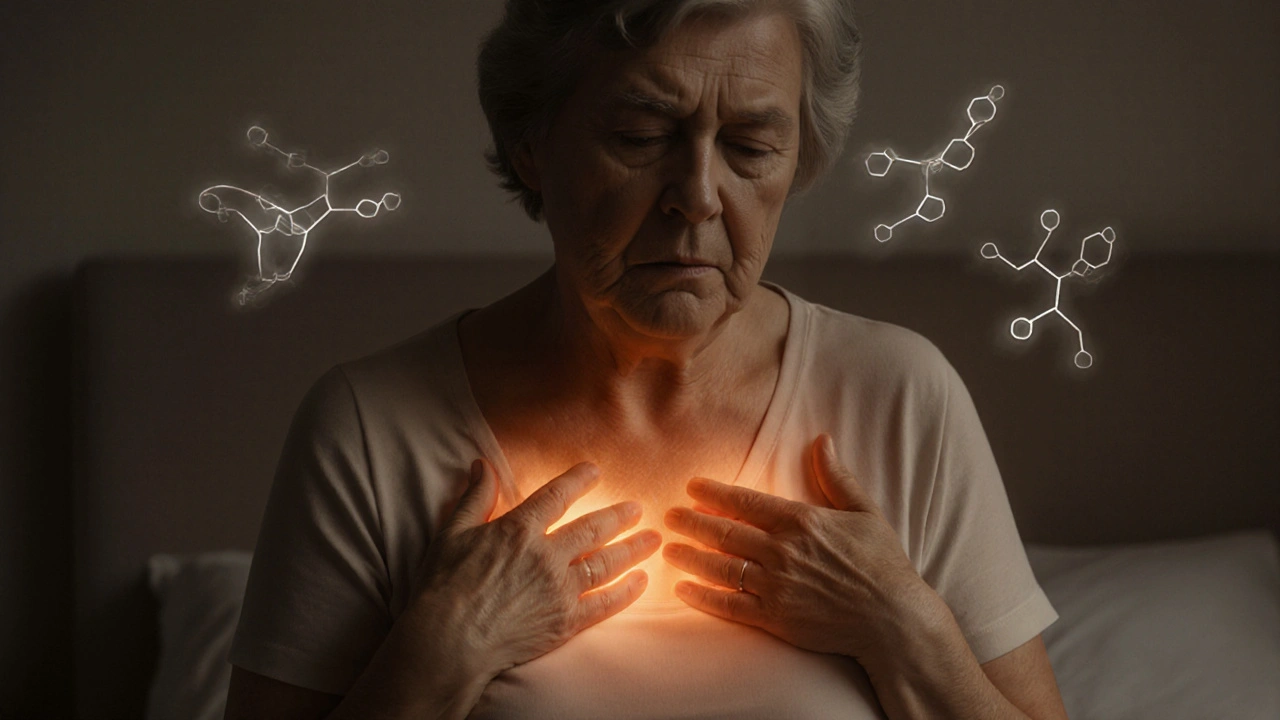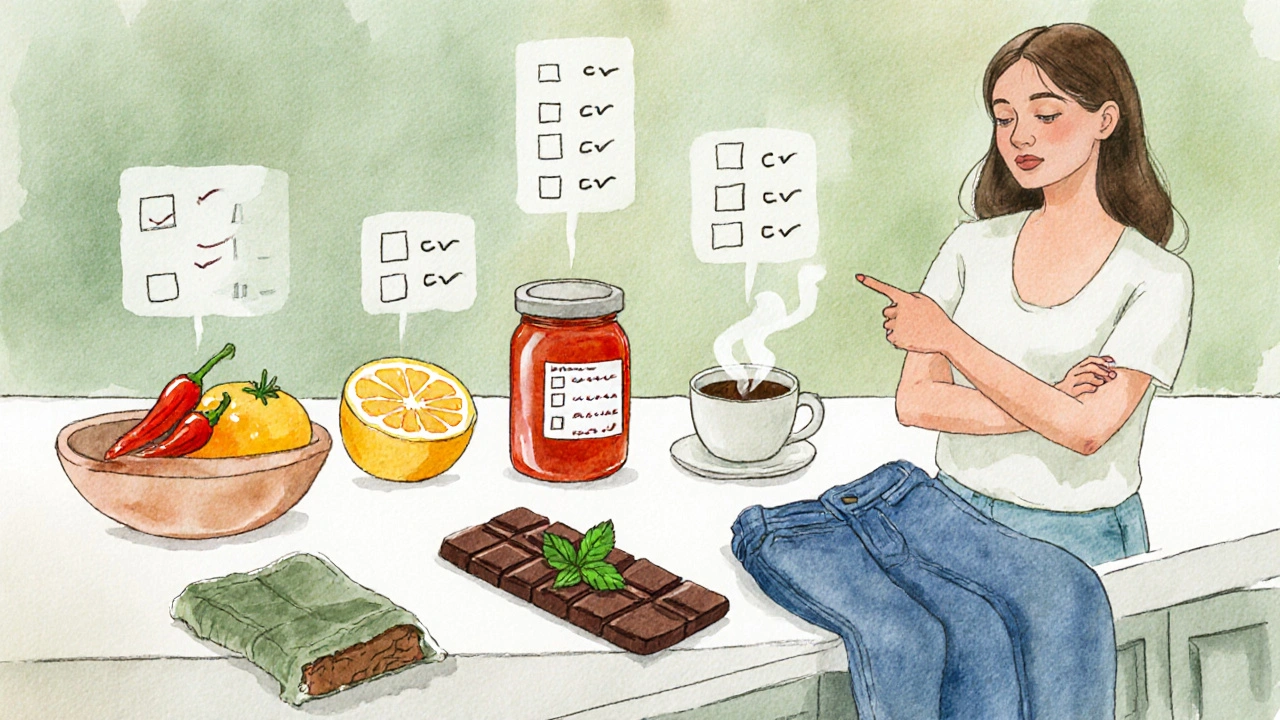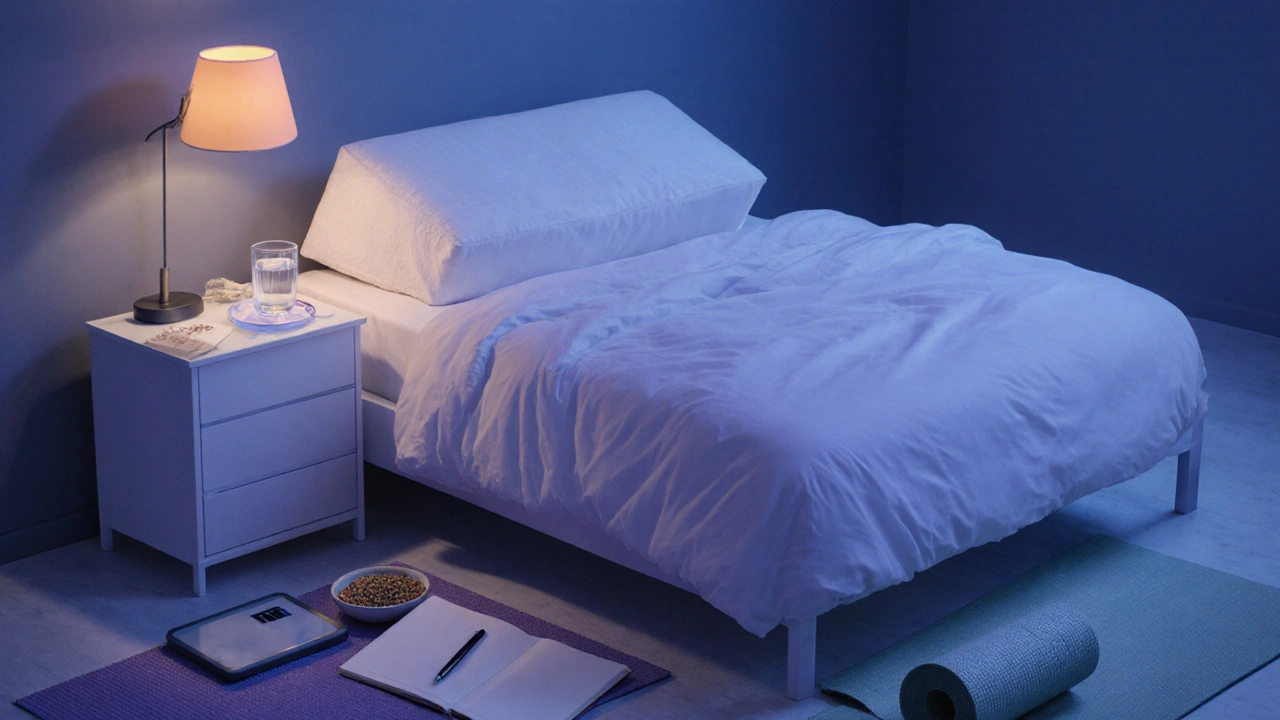 Oct, 1 2025
Oct, 1 2025
Menopause Heartburn Trigger Identifier
During menopause, hormonal changes can make heartburn worse. Identify your personal triggers by rating how much each item affects your symptoms. This tool helps you understand which factors contribute to your heartburn episodes.
Rate triggers above to see your top contributors to heartburn during menopause.
Based on your ratings, personalized tips will appear here to reduce heartburn.
When Heartburn a burning sensation behind the breastbone caused by stomach acid rising into the esophagus flares up during Menopause the natural transition in a woman's life when ovarian hormone production declines, the discomfort can feel relentless. Below you’ll find practical steps that actually work, no vague advice.
Quick Takeaways
- Eat smaller meals and avoid trigger foods 2-3hours before bedtime.
- Raise the head of your bed by 6‑10cm to keep acid down while you sleep.
- Lean on gentle over‑the‑counter options like antacids or H2 blockers before reaching for prescription pills.
- Include phyto‑estrogen foods (flaxseed, soy) and calcium‑rich dairy to support hormonal balance.
- Seek medical help if symptoms persist more than two weeks or are accompanied by weight loss.
Why Heartburn Gets Worse During Menopause
The link isn’t magic; it’s biology. As Estrogen the primary female sex hormone that helps keep the lower esophageal sphincter (LES) relaxed levels fall, the LES can become weaker. A weaker LES lets stomach acid sneak back up the esophagus more easily, leading to the classic burning sensation.
At the same time, Progesterone another ovarian hormone that slows gut motility also drops, slowing digestion and increasing the likelihood of reflux after meals.
These hormonal shifts are often accompanied by weight gain around the abdomen, another factor that pushes stomach contents upward.
Common Triggers to Watch
Even without hormonal changes, certain foods and habits provoke acid reflux. Here’s a quick checklist:
- Spicy foods (chili, hot sauce)
- Citrus fruits and juices
- Tomato‑based sauces
- Chocolate and mint
- Fried or fatty meals
- Caffeinated drinks and alcohol
- Large meals eaten close to bedtime
Identifying your personal culprits is the first step toward relief.
Lifestyle Tweaks That Actually Help
Simple habit changes can dramatically lower the frequency of heartburn episodes:
- Mind the timing: Finish eating at least 2‑3hours before you lie down.
- Elevate the head of your bed: Use a wedge pillow or place blocks under the mattress legs to lift the head 6‑10cm. Gravity becomes your ally.
- Wear loose clothing: Tight waistbands increase abdominal pressure and push acid upward.
- Stay active: Light walks after meals aid digestion, but avoid vigorous exercise right after eating.
- Maintain a healthy weight: Shedding even 5‑10% of body weight can reduce LES pressure.

Smart Dietary Strategies
Focus on foods that soothe the esophagus and support hormone balance:
- Oatmeal, whole grains, and bananas: Low‑acid, easy‑to‑digest carbs.
- Lean proteins: Skinless poultry, fish, and tofu.
- Non‑citrus fruits: Apples, pears, melons.
- Vegetables (cooked or raw): Broccoli, green beans, carrots.
- Phyto‑estrogen sources: Ground flaxseed (1tbsp/day), soy milk, edamame.
- Calcium‑rich foods: Low‑fat yogurt, fortified plant milks. Calcium can neutralize acid and may modestly offset estrogen loss.
Drink plenty of water throughout the day, but limit large volumes during meals to avoid over‑filling the stomach.
Safe Over‑the‑Counter Options
When diet and lifestyle aren’t enough, OTC remedies can bridge the gap. Below is a quick comparison of the three most common categories:
| Product Type | How It Works | Typical Dose | On‑set Time | Pros | Cons |
|---|---|---|---|---|---|
| Antacids alkaline tablets that neutralize stomach acid | Neutralizes acid instantly | 1‑2 tablets after symptoms | Minutes | Fast relief, inexpensive | Can cause rebound acid, may interfere with mineral absorption |
| H2 Blockers reduce acid production by blocking histamine receptors | Decreases acid output | 1 tablet before dinner | 30‑60min | Longer lasting than antacids, safe for short‑term use | May cause headache or mild constipation |
| Proton Pump Inhibitors (PPIs) block the final step of acid secretion | Strongly suppresses acid | 1 capsule each morning | 1‑2hours | Best for frequent or severe reflux | Not recommended for long‑term without doctor supervision |
Start with antacids for occasional flare‑ups. If you need relief most nights, talk to a pharmacist about a short course of H2 blockers. Reserve PPIs for chronic cases after a medical review.
Natural & Hormonal Approaches
Because the root cause is hormonal, supporting estrogen levels can bring lasting benefit.
- Phyto‑estrogen foods: Flaxseed, soy, chickpeas. Aim for 1‑2tbsp of ground flaxseed daily.
- VitaminD and calcium: Adequate levels improve bone health and may reduce reflux episodes.
- Ginger tea: Mild anti‑inflammatory, sip ½‑1cup after meals.
- Chamomile or licorice root tea: Soothes the esophageal lining (avoid if you have hypertension).
- Mind‑body techniques: Yoga, deep breathing, and meditation lower stress‑induced acid production.
If symptoms remain disruptive, a doctor may discuss low‑dose estrogen therapy or selective estrogen receptor modulators (SERMs). These options should only be pursued under professional guidance.
When to Call a Doctor
Most occasional heartburn is benign, but watch for red‑flag signs that merit prompt evaluation:
- Difficulty swallowing or feeling of food stuck
- Persistent pain that wakes you at night
- Unexplained weight loss or loss of appetite
- Vomiting blood or material that looks like coffee grounds
- Chest pain that mimics a heart attack (seek emergency care)
These symptoms could indicate Gastroesophageal Reflux Disease (GERD) a chronic form of reflux that may damage the esophagus or other serious conditions.
Putting It All Together: A 7‑Day Relief Plan
- Day1‑2: Switch to smaller, bland meals; start a bedtime elevation routine.
- Day3‑4: Add a daily tablespoon of ground flaxseed; keep a food‑symptom journal.
- Day5‑6: Try an antacid after any lingering flare‑up; continue the elevation.
- Day7: Review your journal. If two or more triggers appear repeatedly, eliminate them and consider an H2 blocker before dinner.
Adjust the plan based on your personal response. Consistency is key; most women notice a drop in episodes within a week.

Frequently Asked Questions
Can hot water help with heartburn?
Warm water can dilute stomach acid temporarily, offering brief relief. It’s not a substitute for longer‑term strategies, but sipping a glass after meals can be soothing.
Is it safe to take antacids with calcium supplements?
Generally yes, but space them at least 2hours apart. Some antacids contain calcium, and overlapping doses could lead to excess intake.
Do menopause hormone therapies reduce reflux?
Low‑dose estrogen can improve LES tone for some women, but results vary. Always discuss risks such as blood clots with your healthcare provider.
What foods should I avoid before bedtime?
Steer clear of chocolate, peppermint, citrus, tomato sauces, spicy dishes, caffeine, and alcohol for at least 2‑3hours before laying down.
Can weight loss really improve heartburn?
Yes. Reducing abdominal pressure eases the strain on the LES, often cutting nightly reflux episodes in half.
Ellie Hartman
October 1, 2025 AT 14:20I’ve been tracking my heartburn triggers during menopause for a few months now, and the pattern is surprisingly consistent. Small, low‑acid meals taken at least three hours before bed seem to cut nighttime flare‑ups in half. Loose‑fitting pants make a noticeable difference in abdominal pressure, especially after dinner. Adding a tablespoon of ground flaxseed to morning oatmeal has helped smooth digestion and keep the LES tight. Keeping a simple symptom journal can reveal which of the listed culprits are truly yours, so you can target them without over‑restricting your diet.
Alyssa Griffiths
October 2, 2025 AT 04:14One must recognize, without doubt, that the hormonal decline during menopause directly influences lower esophageal sphincter tone; consequently, acid reflux becomes more prevalent, and therefore, the proposed dietary modifications are not merely suggestions but necessities. Moreover, the list of triggers-spicy foods, citrus, chocolate, caffeine-has been corroborated by multiple gastroenterology studies; thus, eliminating them, particularly in the evening, yields measurable symptom reduction. Finally, the recommendation to elevate the head of the bed by 6‑10 cm is supported by randomized controlled trials, which demonstrate a statistically significant decrease in nocturnal reflux episodes.
Cierra Nakakura
October 2, 2025 AT 18:07Wow, this guide is a lifesaver! 🙌 I started swapping my late‑night pizza for a quick banana‑almond smoothie and the burning stopped almost instantly. Also, I’ve been sipping ginger tea after meals – it’s soothing and doesn’t mess with my sleep. 🎉 Small tweaks, big results – keep sharing tips like this! 😊
Sharif Ahmed
October 3, 2025 AT 08:00Indeed, the hormonal cascade during menopause acts like a covert saboteur, stealthily weakening the lower esophageal sphincter. The resulting acid surge is nothing short of theatrical-fireworks in the chest that demand immediate attention. By embracing the suggested lifestyle shifts, one can reclaim control and silence that drama. Let us not underestimate the power of disciplined habit.
Charlie Crabtree
October 3, 2025 AT 21:54Totally agree with the small‑meal tip! 🍽️ I’ve been portioning my dinner and using a wedge pillow, and the night‑time burn is practically gone. Also, a quick reminder: stay hydrated but avoid guzzling water right after meals-it can overfill the stomach. Keep the momentum going! 😎
RaeLyn Boothe
October 4, 2025 AT 11:47Just a heads‑up: if you’re taking calcium supplements, try spacing them away from antacids to avoid absorption issues. Also, swapping out regular coffee for low‑acid cold brew can make a subtle but real difference. Your gut will thank you.
Fatima Sami
October 5, 2025 AT 01:40The article correctly uses the singular “esophagus” rather than the common plural mishap. Additionally, the recommended elevation height of 6‑10 cm aligns with clinical guidelines. Such precision in language mirrors the precision needed in treatment.
Bridget Jonesberg
October 5, 2025 AT 15:34When I first read about the interplay between estrogen loss and LES weakness, I was skeptical, yet the physiological link is unmistakable. The cascade begins with reduced estrogen, which normally helps maintain sphincter tone, followed by progesterone’s decline that slows gastric emptying, creating a perfect storm for reflux. Weight gain around the abdomen compounds the issue by physically pressing the stomach upward, further encouraging acid escape. Consequently, a multi‑pronged approach-dietary adjustments, weight management, and strategic bedtime elevation-is essential. I’ve personally found that eliminating chocolate after dinner and incorporating a nightly 10‑minute gentle yoga flow dramatically curbs nighttime heartburn. Moreover, the inclusion of phyto‑estrogen foods like flaxseed adds a hormonal buffer that many overlook. In short, the synergy of these steps transforms a daunting symptom into a manageable routine.
Marvin Powers
October 6, 2025 AT 05:27Let’s unpack why these recommendations actually work, step by step, and why they’re especially relevant during the menopausal transition. First, the hormonal dip specifically reduces estrogen’s protective effect on the lower esophageal sphincter, making it more permissive to acid back‑flow. Second, progesterone’s decline slows gastric motility, meaning food stays longer in the stomach, increasing the chance of reflux. Third, many women experience a shift in body composition, with visceral fat accumulating around the waist; this creates additional intra‑abdominal pressure that forces acid upward.
Addressing these three physiological pillars can be done with fairly simple lifestyle tweaks. Small, frequent meals reduce gastric distension, thereby lowering pressure on the LES. By finishing eating at least two to three hours before bedtime, you give the stomach a chance to empty, which decreases the volume available for reflux at night. Elevating the head of the bed by 6‑10 cm uses gravity as an ally, keeping acid where it belongs.
Dietary changes also play a pivotal role. Acidic foods-citrus, tomato‑based sauces-and irritants like spicy peppers and mint can directly stimulate acid production or relax the LES. Substituting these with low‑acid options such as oats, bananas, and non‑citrus fruits delivers nutrition without the burn. Incorporating lean proteins-skinless poultry, fish, tofu-supports satiety without the fat‑induced delay in gastric emptying.
Don’t overlook the power of phyto‑estrogens. Ground flaxseed, soy milk, and edamame contain plant‑derived estrogenic compounds that can modestly bolster the estrogen deficit, potentially improving LES tone over time. Even a modest daily dose of one to two tablespoons of ground flaxseed has been shown to support both hormonal balance and digestive health.
When dietary and positional strategies fall short, over‑the‑counter options become useful. Antacids offer rapid, short‑term neutralization of stomach acid; they’re ideal for occasional flare‑ups. H2 blockers, taken before dinner, provide longer‑lasting reduction in acid production without the systemic effects of prescription PPIs. Reserve PPIs for chronic, severe reflux after a physician’s assessment, as they suppress acid secretion more potently but carry higher risk with prolonged use.
Stress management is another often‑ignored factor. Chronic anxiety elevates cortisol, which can increase gastric acid secretion. Simple techniques-deep breathing, meditation, or a brief post‑meal walk-can blunt this response.
Lastly, consider the impact of weight management. Even a modest 5‑10 % reduction in body weight can lower intra‑abdominal pressure, improving LES function and cutting nightly reflux episodes in half. A combination of balanced nutrition, regular low‑impact activity, and mindful eating habits can make this achievable.
In summary, the convergence of hormonal shifts, anatomical changes, and lifestyle factors underpins the heightened heartburn risk during menopause. By methodically applying the outlined strategies-timed meals, bed elevation, trigger avoidance, phyto‑estrogen inclusion, stress reduction, and prudent OTC use-most women can experience a measurable decline in reflux frequency within a week. Consistency is key, and monitoring your symptoms daily will help you fine‑tune the plan to your unique physiology.
Kyle Olsen
October 6, 2025 AT 19:20The recommendation to elevate the head of the bed is evidence‑based.
Darla Sudheer
October 7, 2025 AT 09:14Great point about the timing of meals; letting the stomach settle before lying down really does cut the night‑time burn.
Elizabeth González
October 7, 2025 AT 23:07From a philosophical standpoint, the interplay between physiological change and environmental adaptation underscores the perennial human quest for equilibrium. Recognizing that menopause is not merely a symptom but a systemic transition invites a more holistic approach to health.
Frank Reed
October 8, 2025 AT 13:00I’m lovin the flaxseed tip – adds a nutty flavor and keeps my gut happy.
Bailee Swenson
October 9, 2025 AT 02:54Seriously, stop ignoring the waistband issue – tight pants are a nightmare for reflux! 😡🔥
tony ferreres
October 9, 2025 AT 16:47Oh sure, just sprinkle some soy and the reflux disappears – as if it’s that simple 😏🤦♂️
Kaustubh Panat
October 10, 2025 AT 06:40The discourse surrounding menopausal gastro‑esophageal dynamics necessitates a reevaluation of conventional dietary dogma; one must eschew the prosaic reliance on anecdotal exclusions and instead adopt a rigorously quantified, evidence‑anchored paradigm.
Arjun Premnath
October 10, 2025 AT 20:34I appreciate the call for a data‑driven approach; pairing symptom logs with nutrient analysis will empower many to tailor their regimen effectively.
Mark Rohde
October 11, 2025 AT 10:27Another day, another heartburn saga – thanks for the generic tips that everyone’s already tried.
Rajan Desai
October 12, 2025 AT 00:20It would be valuable to see a statistical breakdown of trigger prevalence among different age brackets within the menopausal cohort.